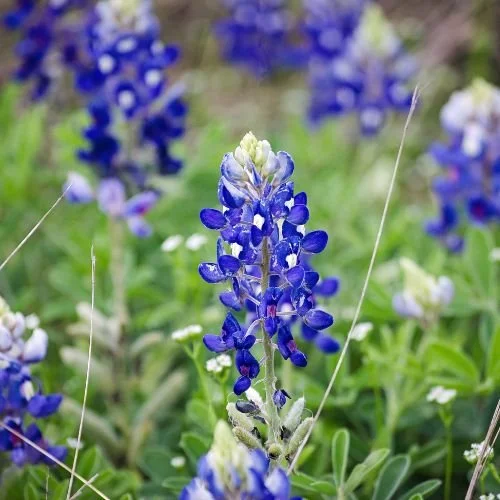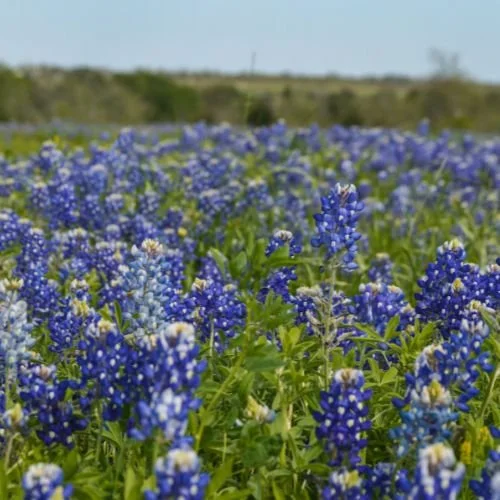

Organic Blue Bonnet Seeds
Bluebonnet (Lupinus texensis)
Bluebonnets, primarily Lupinus texensis, are iconic annual wildflowers deeply woven into the cultural and natural fabric of Texas. Known for transforming vast landscapes into stunning seas of blue in spring, they are the state flower of Texas and a beloved symbol of its wild beauty. These resilient plants are found across the state, from roadsides to prairies, and are admired for their ecological contributions.
Plant Benefits:
Nitrogen Fixation: As legumes, bluebonnets have a unique ability to "fix" nitrogen in the soil through a symbiotic relationship with specific soil bacteria (Rhizobium). This process enriches the soil, naturally improving its fertility and benefiting the growth of other plants.
Pollinator Attraction: Their vibrant blue-violet flowers, often tipped with white, are a magnet for a wide array of pollinators, especially bees and butterflies. They provide essential nectar and pollen in early spring, supporting local biodiversity and ecosystem health.
Drought Tolerance and Resilience: Bluebonnets are well-adapted to the sometimes harsh Texas climate. They possess deep taproots that allow them to access moisture deep within the soil, enabling them to survive extreme droughts, intense heat, and even occasional freezing temperatures.
Erosion Control: Their widespread root systems can help stabilize soil, particularly on slopes, contributing to natural erosion control.
Low Maintenance: Once established, bluebonnets are incredibly low maintenance. They are adapted to thrive in tough soil conditions and generally do not require fertilization or excessive watering.
Aesthetic Value: Beyond their ecological benefits, bluebonnets provide immense aesthetic value, creating breathtaking landscapes that draw visitors and photographers and serve as a cherished symbol of Texas's natural heritage.
Traditional and Cultural Significance:
Bluebonnets have a rich history in Texas, inspiring numerous Native American tales and becoming a focal point of spring traditions for Texans. While there's a myth that Spanish priests brought them from Europe, the most predominant species are native only to Texas. Their beauty is celebrated in art, literature, and music, and they are central to many spring festivals across the state. The Texas Department of Transportation actively sows bluebonnet seeds along highways as part of a beautification program.
Planting Instructions:
When to Plant: Bluebonnet seeds are best sown in late fall (September through December 15th, with early October or November being ideal). This allows the seeds to undergo natural cold stratification and scarification over winter, preparing them for germination in early spring. They are annuals, completing their life cycle from seed to flower to seed within one year.
Light Requirements: Bluebonnets require full sun for optimal growth and prolific blooming, ideally at least 8-10 hours of direct sunlight daily. They can tolerate some partial shade, but flowering may be diminished.
Soil: Adaptable to various soil types, bluebonnets prefer alkaline, well-drained soil that is moderate in fertility. They can thrive in poor, rocky, or even decomposed granite soils. Good drainage is crucial; they will not tolerate waterlogged conditions or heavy clay soils unless amended. Fertilizing is generally not recommended as it can encourage leafy growth over blooms, and they naturally fix nitrogen.
Sowing Seeds:
Scarification: Bluebonnet seeds have a very hard coat, which can lead to low germination rates. To improve germination, scarification is often necessary. This can be done by:
Naturally: Planting in the fall allows winter weather and precipitation to naturally break down the seed coat.
Manually (for spring planting): Nicking individual seeds with a knife, rubbing them with sandpaper, or briefly soaking them in hot water after freezing them overnight. If scarifying, plant immediately.
Surface Sow: Gently press seeds into the soil surface or cover no more than 1/4 inch deep. They need light to germinate.
Seed-to-Soil Contact: Ensure good seed-to-soil contact by lightly tamping down the soil over the seeds, either by hand or by walking over the area.
Spacing: If broadcasting, aim for 8-10 seeds per square foot. If planting individually, space plants 6-12 inches apart as they will quickly fill in.
Watering: Keep the soil consistently moist until germination (which can take 14-30 days and sometimes even longer, as seeds can remain dormant for up to 18 months). Once established, bluebonnets are drought-tolerant and prefer drier conditions; avoid overwatering, as it can cause rot.
Rhizobium Inoculation: In areas where bluebonnets haven't grown before, inoculating the soil or seeds with a specific Rhizobium bacterium for lupines can improve plant growth and flowering.
Maintenance: Bluebonnets are generally low maintenance. Avoid mowing areas where they are growing until after the seed pods have fully matured and dispersed their seeds (typically when the foliage has turned brown). This ensures self-seeding for the following year.
Bluebonnet (Lupinus texensis)
Bluebonnets, primarily Lupinus texensis, are iconic annual wildflowers deeply woven into the cultural and natural fabric of Texas. Known for transforming vast landscapes into stunning seas of blue in spring, they are the state flower of Texas and a beloved symbol of its wild beauty. These resilient plants are found across the state, from roadsides to prairies, and are admired for their ecological contributions.
Plant Benefits:
Nitrogen Fixation: As legumes, bluebonnets have a unique ability to "fix" nitrogen in the soil through a symbiotic relationship with specific soil bacteria (Rhizobium). This process enriches the soil, naturally improving its fertility and benefiting the growth of other plants.
Pollinator Attraction: Their vibrant blue-violet flowers, often tipped with white, are a magnet for a wide array of pollinators, especially bees and butterflies. They provide essential nectar and pollen in early spring, supporting local biodiversity and ecosystem health.
Drought Tolerance and Resilience: Bluebonnets are well-adapted to the sometimes harsh Texas climate. They possess deep taproots that allow them to access moisture deep within the soil, enabling them to survive extreme droughts, intense heat, and even occasional freezing temperatures.
Erosion Control: Their widespread root systems can help stabilize soil, particularly on slopes, contributing to natural erosion control.
Low Maintenance: Once established, bluebonnets are incredibly low maintenance. They are adapted to thrive in tough soil conditions and generally do not require fertilization or excessive watering.
Aesthetic Value: Beyond their ecological benefits, bluebonnets provide immense aesthetic value, creating breathtaking landscapes that draw visitors and photographers and serve as a cherished symbol of Texas's natural heritage.
Traditional and Cultural Significance:
Bluebonnets have a rich history in Texas, inspiring numerous Native American tales and becoming a focal point of spring traditions for Texans. While there's a myth that Spanish priests brought them from Europe, the most predominant species are native only to Texas. Their beauty is celebrated in art, literature, and music, and they are central to many spring festivals across the state. The Texas Department of Transportation actively sows bluebonnet seeds along highways as part of a beautification program.
Planting Instructions:
When to Plant: Bluebonnet seeds are best sown in late fall (September through December 15th, with early October or November being ideal). This allows the seeds to undergo natural cold stratification and scarification over winter, preparing them for germination in early spring. They are annuals, completing their life cycle from seed to flower to seed within one year.
Light Requirements: Bluebonnets require full sun for optimal growth and prolific blooming, ideally at least 8-10 hours of direct sunlight daily. They can tolerate some partial shade, but flowering may be diminished.
Soil: Adaptable to various soil types, bluebonnets prefer alkaline, well-drained soil that is moderate in fertility. They can thrive in poor, rocky, or even decomposed granite soils. Good drainage is crucial; they will not tolerate waterlogged conditions or heavy clay soils unless amended. Fertilizing is generally not recommended as it can encourage leafy growth over blooms, and they naturally fix nitrogen.
Sowing Seeds:
Scarification: Bluebonnet seeds have a very hard coat, which can lead to low germination rates. To improve germination, scarification is often necessary. This can be done by:
Naturally: Planting in the fall allows winter weather and precipitation to naturally break down the seed coat.
Manually (for spring planting): Nicking individual seeds with a knife, rubbing them with sandpaper, or briefly soaking them in hot water after freezing them overnight. If scarifying, plant immediately.
Surface Sow: Gently press seeds into the soil surface or cover no more than 1/4 inch deep. They need light to germinate.
Seed-to-Soil Contact: Ensure good seed-to-soil contact by lightly tamping down the soil over the seeds, either by hand or by walking over the area.
Spacing: If broadcasting, aim for 8-10 seeds per square foot. If planting individually, space plants 6-12 inches apart as they will quickly fill in.
Watering: Keep the soil consistently moist until germination (which can take 14-30 days and sometimes even longer, as seeds can remain dormant for up to 18 months). Once established, bluebonnets are drought-tolerant and prefer drier conditions; avoid overwatering, as it can cause rot.
Rhizobium Inoculation: In areas where bluebonnets haven't grown before, inoculating the soil or seeds with a specific Rhizobium bacterium for lupines can improve plant growth and flowering.
Maintenance: Bluebonnets are generally low maintenance. Avoid mowing areas where they are growing until after the seed pods have fully matured and dispersed their seeds (typically when the foliage has turned brown). This ensures self-seeding for the following year.